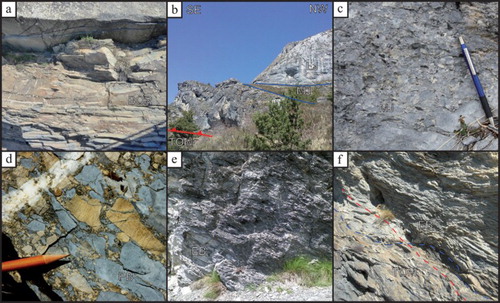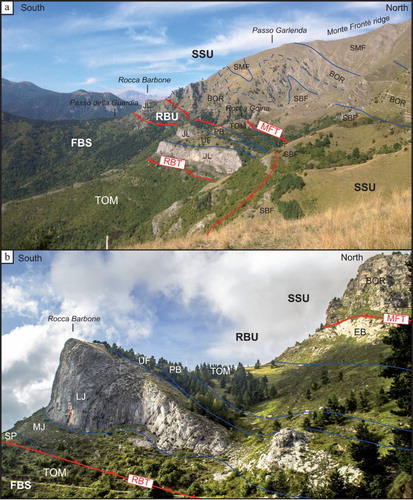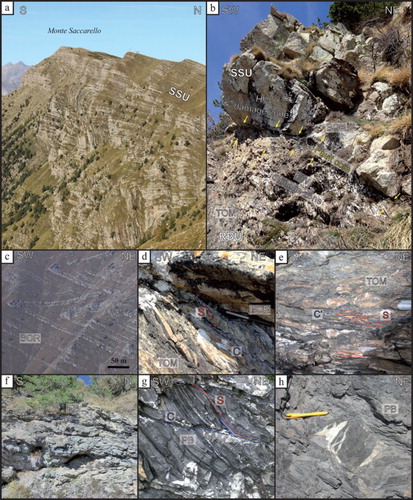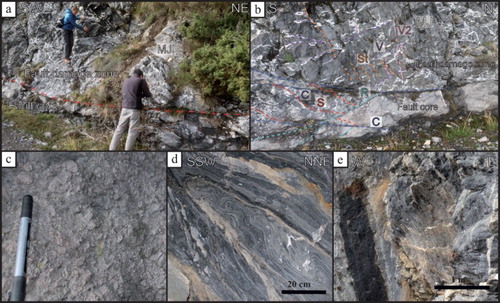Figures & data
Figure 1. (a) Location of the study area. (b) Tectonic sketch of the Western and Ligurian Alps, simplified after CitationCeriani et al. (2001) and CitationMaino, Decarlis, Felletti, and Seno (2013). Tectonic units are grouped in Internal (Piedmont, Piedmont-Ligurian and Briançonnais) and External (Provençal-Dauphinois, Helvetic and External Massifs) domains. The yellow box shows the location of the Monte Fronté Thrust zone along the PBC. DB: Dent Blanche nappe (Austroalpine domain); E-U: Embrunais-Ubaye nappes; HF: Helminthoid Flysch nappes; TH-M: Torino hill and Monferrato high; TPB: Tertiary Piedmont Basin.

Figure 2. Simplified lithostratigraphic log of the successions cropping out in the study area (not to scale).

Figure 3. (a) Quartz-feldspatic sandstones interlayered with marls and clay ‘chips’ (BOR); (b) Triassic-Jurassic dolostones and limestones (LJ: Late Jurassic light grey limestones; MJ: Middle Jurassic dark limestones; SP: Triassic dolostones) of the Rocca Barbone Unit thrusted above the ‘TOM’ of the foreland basin succession; (c) breccia and conglomerate layers characterizing the base of the Briançonnais-type Middle Jurassic limestones; (d) Eocene polygenetic breccias (PB) with Triassic to Eocene clasts; (e) strongly foliated block of Late Cretaceous marly limestones (EB); (f) detail of a thrust-related tectonic cleavage (red line) cutting the stratigraphic boundary (blue line) between a megablock of Late Cretaceous marly limestones (EB) embedded within the TOM of the Rocca Barbone Unit.

Figure 4. (a) Panoramic view of the studied Ligurian segment of the Penninic Basal Thrust (see section B–B′ on the Main Map); (b) the Rocca Barbone Unit is bounded by two thrust planes (MFT and RBT – Monte Frontè Thrust and Rocca Barbone Thrust, respectively). BOR: Bordighera sandstones Fm.; EB Block of Late Cretaceous marly limestones; FBS: Foreland basin succession; JL: Jurassic limestones; LJ: Late Jurassic limestones; MJ: Middle Jurassic limetones; PB: Eocene polygenetic breccias; RBU: Rocca Barbone Unit; SBF: San Bartolomeo Fm.; SMF: San Remo Flysch; SSU: San Remo-Monte Saccarello Unit; SP: Triassic dolostones; TOM: ‘Triora Olistostrome Member’; UF: Late Cretaceous marly limestones of the Upega Fm.

Figure 5. (a) Late Cretaceous arkoses and limestones of the San Remo-Monte Saccarello Unit (SSU) involved in SW-verging folding above the MFT; (b) The fault zone of the MFT at the contact between the Bordighera Sandstones (BOR) and the ‘TOM’; (c) detail of close folds within the BOR, close to the Monte Fronté Thrust; (d) detail of the core zone showing the developing S-C bands within the TOM; (e) C′ bands locally occurring within the TOM embedded in the fault core; (f) folds within a block of Late Cretaceous marly limestones from the fault damage zone; (g), (h) s-c bands and sigma-shaped clast of limestone with trails filled with calcite from the Eocene polygenetic breccias (PB) involved in the damage zone.

Figure 6. Lower hemisphere, equal area stereonets of representative structural data from the study area. RB unit: Rocca Barbone Unit; SS unit: San Remo – Monte Saccarello Unit; St: stylolitic cleavage planes; T: main thrust surface; V and V2: fractures filled with quartz or calcite. N indicates the number of measurements.

Figure 7. (a) The fault zone of the Rocca Barbone Thrust here developed at the base of the Middle Jurassic limestones (MJ) showing, (b), a stylolitic cleavage (St) developed into the fault damage zone, S-C fabric in the fault core and a widespread distribution of veined fractures (V and V2). (c) Detail of the cataclastic breccias from the fault core; (d) plastically folded Triassic limestones comprised within the fault core; (e) later, NW-dipping normal faults, cutting the thrust-related fault zone.

